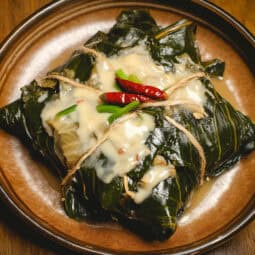
Pinangat ng Bicol (Tilmok, Tinulmok or Tinuktuk)
Pinangat ng Bicol (also known as Tilmok, Tinulmok or Tinuktuk) is a distinctive Bicolano dish where minced freshwater shrimp and young coconut meat are combined with aromatics, wrapped in fresh taro leaves, and gently simmered in coconut milk. The parcels are finished with a rich coconut cream sauce infused with lemongrass, garlic, and shallots, creating a dish that embodies the coconut-rich culinary traditions of the Bicol region.
Equipment
- Large pot with lid (kaldero) for steaming the Pinangat
- Food processor or large knife (panggilingan) for mixing ingredients
- Kitchen twine (Pisi) for securing the leaves
- Heavy-bottom cooking pot (makapal na kaldero) for even heat distribution
- Measuring cups and spoons (Panukat) for precise measurement
- Chopping board (sangkalan)
- Sharp knife (matulis na kutsilyo)
- Grater (kudkuran) for coconut meat
Ingredients
For the Filling:
- ½ kg freshwater shrimp hipon, peeled and seasoned with 1½ tablespoon salt
- 600 g young coconut meat buko, about 5 young coconuts, grated
- 2 onions sibuyas, chopped
- 2 tablespoon grated ginger luya
- 6 cloves garlic bawang
- Chilies siling labuyo to taste
- 20-30 fresh taro leaves dahon ng gabi - must be intact without holes
- Kitchen string
- 6-8 stalks lemongrass tanglad, white portions only, smashed
- 3-4 cups pure coconut milk gata
For the Sauce/Topping:
- 2 cups thick coconut cream kakang gata
- 5 cloves garlic bawang, finely chopped
- 4 shallots sibuyas tagalog, finely chopped
- 2 stalks lemongrass tanglad, white portions sliced
- Salt asin to taste
- 3-5 spring onions dahon ng sibuyas, finely chopped
Instructions
- Start by preparing the filling. Using a food processor or large knife, combine the peeled and salted freshwater shrimp (hipon), grated young coconut meat (buko), chopped onions (sibuyas), grated ginger (luya), garlic (bawang), and chilies (siling labuyo) until the mixture resembles cornmeal texture (parang giniling). Keep this mixture at room temperature while preparing the leaves.
- Carefully inspect fresh taro leaves (dahon ng gabi) to ensure they have no holes or spots, as these can cause leaks during cooking. Lay out overlapping taro leaves in your work area. Place approximately 3 tablespoons of the prepared filling mixture in the center of the leaves. Wrap the leaves carefully around the filling, making sure to seal the edges well, and tie securely with kitchen string (pisi) or use the taro leaf stalks as natural ties.
- Before cooking, prepare your pot by lining the bottom with smashed lemongrass stalks (tanglad). Arrange the wrapped Pinangat packets carefully in the pot, then pour in 3-4 cups of pure coconut milk (gata) until the packets are mostly covered. Bring to a gentle simmer over low heat (160°F/71°C), cover the pot, and cook for 45-60 minutes, occasionally shaking the pot gently to prevent sticking. The Pinangat is done when the leaves are soft and most of the coconut milk has been absorbed.
- While the Pinangat is cooking, prepare the sauce. In a separate pan over medium-low heat (175°F/79°C), combine 2 cups of thick coconut cream (kakang gata) with finely chopped garlic, shallots (sibuyas tagalog), and sliced lemongrass. Simmer until the sauce becomes thick and creamy, then season with salt (asin) to taste. Just before removing from heat, stir in finely chopped spring onions (dahon ng sibuyas).
- Serve the Pinangat hot with steamed white rice (kanin), generously spooning the prepared sauce over each portion. The dish can be stored in an airtight container in the refrigerator for up to 3 days, or frozen for up to 1 month. When reheating, steam for 10-15 minutes or microwave with a damp cloth cover. Remember not to reheat more than once for food safety.
Tips from Lola's Kitchen
- Choose young taro leaves for better wrapping and texture
- Test taro leaves for freshness by checking for holes or spots
- Squeeze coconut cream from fresh coconuts for best results
- Toast grated coconut slightly before mixing for enhanced flavor
- Use banana leaf strips as alternative ties for authentic touch
Nutrition
Calories: 320kcalCarbohydrates: 15gProtein: 18gFat: 24gSaturated Fat: 30gPolyunsaturated Fat: 0.4gMonounsaturated Fat: 1gSodium: 580mgPotassium: 504mgFiber: 4gSugar: 9gVitamin A: 62IUVitamin C: 10mgCalcium: 43mgIron: 3mg
Tried this recipe?Let us know how it was!